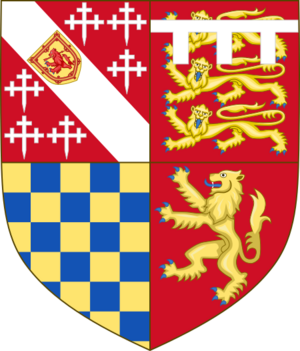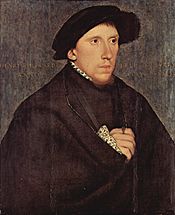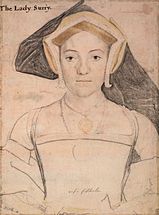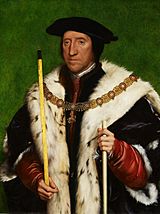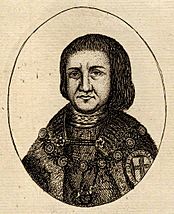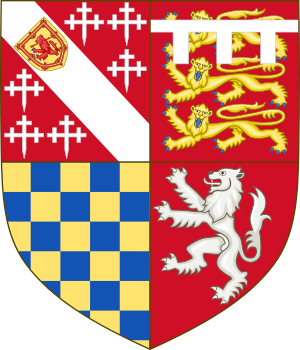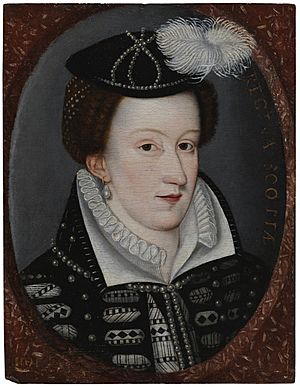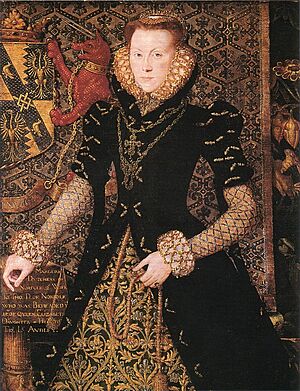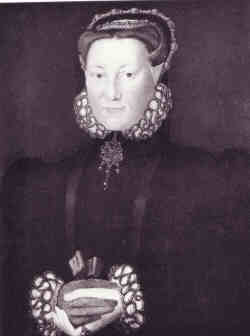Thomas Howard, 4th Duke of Norfolk facts for kids
Quick facts for kids
Thomas Howard, 4th Duke of Norfolk
|
|
|---|---|
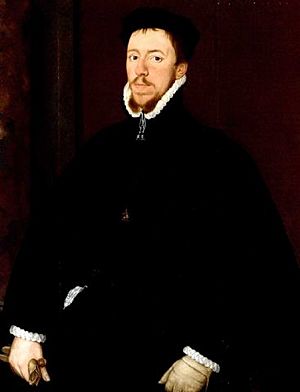
Thomas Howard painted by an unknown artist, c. 1565.
|
|
| Personal details | |
| Born | 10 March 1536 Kenninghall, Norfolk |
| Died | 2 June 1572 (aged 36) Tower Hill, London, England |
| Resting place | Chapel of St Peter ad Vincula, Tower of London |
| Spouses | Mary FitzAlan Margaret Audley Elizabeth Leyburne |
| Children | Philip Howard, 13th Earl of Arundel Thomas Howard, 1st Earl of Suffolk Lord William Howard Lady Elizabeth Howard Lady Margaret Howard |
| Parents | Henry Howard, Earl of Surrey Frances de Vere |
| Religion | Roman Catholicism |
Thomas Howard, 4th Duke of Norfolk (born March 10, 1536 – died June 2, 1572) was an important English nobleman and politician. He was a second cousin to Queen Elizabeth I. He held many high positions during the early part of her rule.
Thomas Howard was the son of Henry Howard, Earl of Surrey, who was a poet, soldier, and politician. It is thought that Thomas Howard asked the famous composer Thomas Tallis to create his well-known song, Spem in alium, around 1567.
He was put to death because of his part in the Ridolfi plot, a plan against the Queen.
Contents
Early Life and Family Background
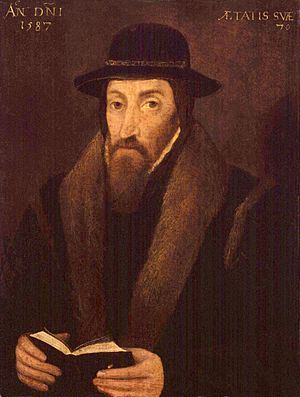
Thomas was born in Kenninghall, Norfolk, on March 10, 1536. He was the oldest son of Henry Howard, Earl of Surrey and Lady Frances de Vere. His family was very important in England.
His grandfathers had different religious beliefs. His mother's father supported the Reformation, which led to the Church of England. His father's father, the 3rd Duke of Norfolk, was a leading Catholic nobleman. Even so, he followed King Henry VIII's changes to the Church.
Thomas's father, the Earl of Surrey, was Catholic but open to some reforms. He was supposed to become the next Duke. However, King Henry VIII became angry with him. The King thought Surrey and his father were planning to take the throne. This was because the Howards were related to the royal family. They were also seen as enemies by the Seymour family, who supported Protestantism.
King Henry VIII ordered the arrest of both the Duke and his son. They were found guilty of treason, which is a crime against one's country. Surrey was executed in January 1547. The 3rd Duke was supposed to be executed too, but the King died first. The Duke remained a prisoner in the Tower of London for six years. Most of his land and titles were taken by the Crown.
After his father died, Thomas and his siblings were cared for by their aunt, Mary Howard. John Foxe, a Protestant writer, became their teacher. They learned Greek and Latin very well. Even though they had a Protestant teacher, Thomas and his family remained Catholic.
When the Catholic Queen Mary I came to the throne in 1553, Thomas's grandfather was released from the Tower. He then took charge of his grandchildren and sent Foxe away. Thomas continued his education with Catholic priests.
Becoming a Leader
Because his father died before his grandfather, Thomas was next in line to become the 4th Duke of Norfolk. In 1553, Queen Mary gave back the family's titles and lands. Thomas then received the title of Earl of Surrey.
In 1554, young Thomas helped his grandfather lead forces to stop Wyatt's Rebellion. This was a group of Protestants who did not want Queen Mary to marry Philip II of Spain.
After his grandfather died in August 1554, Thomas became the 4th Duke of Norfolk. He also became the hereditary Earl Marshal of England. This meant he was in charge of important ceremonies and military matters. Thomas was still young, so his family's properties were managed by the Crown for a while. When he turned 21 in March 1557, he took control of all his estates. This made him one of the wealthiest landowners in England.
In November 1558, Queen Mary died. Her Protestant half-sister, Elizabeth I, became Queen. Thomas Howard was Elizabeth's second cousin. Even though his family had Catholic leanings, Elizabeth trusted him with public office.
As Earl Marshal, Thomas helped organize Queen Elizabeth's coronation in January 1559. Soon after, the Queen made him a Knight of the Garter, a very important honor.
In 1559, Thomas was made Lieutenant-General of the North. This meant he was in charge of the army in northern England. He was sent to Scotland to help Protestant nobles who were against the French-backed government there. Thomas helped negotiate the Treaty of Berwick in February 1560. This treaty brought English help to the Scottish Protestants.
Mary, Queen of Scots, and the Northern Rebellion
In 1568, Thomas Howard was a main leader at a meeting in York. This meeting looked into evidence against Mary, Queen of Scots. Mary had fled Scotland and was a prisoner in England.
Thomas Howard, who had lost his third wife, began to think about marrying Mary. This would have been the fourth marriage for both of them. Both Thomas and Mary were related to the old English royal family. Mary also had a strong claim to the English throne. Many Catholics believed she should be Queen instead of Elizabeth, who was Protestant. Marrying Mary would have given Thomas more power. It would also help Mary strengthen her claim to the throne.
At first, Thomas and Mary communicated through letters. Mary sent him a special embroidered pillow. Thomas sent her a diamond as a sign of his loyalty.
Many Catholic nobles supported the idea of Thomas marrying Mary. Some even thought he would lead a revolt against Queen Elizabeth. In November 1569, the Rising of the North began. This rebellion was led by Thomas's brother-in-law and another Earl. Thomas briefly took part, hoping to free Mary.
After some early success, the rebellion failed. Its leaders had to escape to Scotland. Queen Elizabeth ordered Thomas's arrest. He was held in the Tower of London until August 1570. He was released because there wasn't enough direct proof against him at that time. He also confessed his intentions and asked the Queen for mercy.
The Ridolfi Plot and Execution
After Thomas was released, an Italian banker named Roberto Ridolfi contacted him. Ridolfi was planning a plot to free Mary, put her on the English throne, and bring Catholicism back to England. This plan was supported by the Pope. It also involved Philip II of Spain and his army.
Thomas Howard agreed to join the plot. He asked the Spanish King to approve his marriage to Mary, Queen of Scots.
Thomas's involvement was discovered when his secretary was careless with a secret letter. Queen Elizabeth's chief minister, William Cecil, found out about it. Thomas's servants were questioned and revealed more information. Thomas was sent back to the Tower of London in September 1571.
At first, Thomas denied being part of the Ridolfi plot. But he later admitted it. The evidence against him was now very strong. It showed he was involved in a plan to overthrow and even kill Queen Elizabeth.
Thomas's trial was held on January 16, 1572. It lasted twelve hours. He pleaded that he was innocent. However, the jury of noblemen found him guilty of treason. He was sentenced to death.
Queen Elizabeth was sad about his death because he was her cousin and a respected nobleman. She hesitated to sign the order for his execution. But Parliament strongly pushed for it. They believed he was a threat to the country.
On June 2, 1572, Thomas Howard was led to a special platform on Tower Hill. He spoke to the crowd, admitting he deserved to die but also saying he was partly innocent. He denied being a Catholic, even though many believed he was. After saying goodbye to his friends, he put his head on the block.
Thomas Howard was the first nobleman executed during Queen Elizabeth's reign. He was buried in the Chapel of St. Peter ad Vincula in the Tower of London. His lands and titles were taken away, but much of his property was later given back to his sons. The title of Duke of Norfolk was restored to his family many years later.
Marriages and Children
Thomas Howard was married three times and had several children.
First Marriage
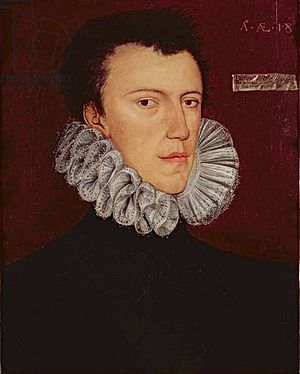
In March 1555, Thomas married his first wife, Mary FitzAlan. She was 14 or 15 years old. This marriage was planned to bring together two important Catholic families in England. Mary brought many properties to the marriage, including Arundel Castle.
Mary gave birth to their only child, a son, on June 28, 1557:
- Philip Howard (1557–1595). He became the Earl of Arundel after his mother's family. Philip remained Catholic and was imprisoned in the Tower of London. He died there and was later recognized as a Catholic martyr. His tomb is in Arundel Cathedral.
Mary died in August 1557, shortly after Philip's birth, likely from illness.
Second Marriage
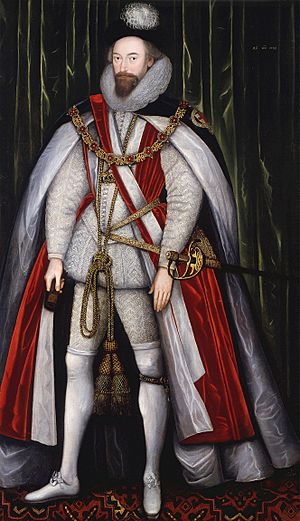
In early 1558, Thomas became engaged to Margaret Audley. She was a widow and a cousin of his first wife. Margaret brought many properties from her father, including the grand Audley End home.
Thomas and Margaret had four children:
- Lady Elizabeth Howard (1560–?), who died as a young child.
- Thomas Howard, 1st Earl of Suffolk (1561–1626).
- Lady Margaret Howard (1562–1591).
- Lord William Howard (1563–1640).
Margaret died in January 1564, shortly after giving birth to her fourth child.
Third Marriage
Soon after Margaret's death, Thomas married Elizabeth Leyburne (1536–1567). She was a widow with two daughters. Thomas and Elizabeth did not have any children together.
Interestingly, Thomas's three sons from his first two marriages (Philip, Thomas, and William) later married Elizabeth Leyburne's daughters from her previous marriage. This meant they married their stepsisters.
Elizabeth died in September 1567, shortly after giving birth to a baby who also died.
Depictions in Media
- Thomas Howard appears as a character in the novels The Virgin's Lover and The Other Queen by Philippa Gregory, and in I, Elizabeth by Rosalind Miles.
- He is played by Christopher Eccleston in the 1998 film Elizabeth.
- Kevin McKidd plays him in the BBC mini-series The Virgin Queen.
- In the Channel 4 documentary Elizabeth (2000), he is played by John Gully.
Images for kids
See also
 In Spanish: Thomas Howard para niños
In Spanish: Thomas Howard para niños


